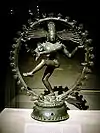Amarnath Temple
The Amarnath Temple is a Hindu shrine located in the Pahalgam tehsil of the Anantnag district of Jammu and Kashmir, India. A cave situated at an altitude of 3,888 m (12,756 ft),[1] about 168 km from Anantnag city, the district headquarters, 141 km (88 mi) from Srinagar, the summer capital of Jammu and Kashmir, reached through either Sonamarg or Pahalgam. It is an important shrine in Hinduism.[2][3] The cave, located in Sind Valley, is surrounded by glaciers, snowy mountains and is covered with snow most of the year, except for a short period in the summer, when it is open to pilgrims. In 1989, pilgrims numbered between 12,000 and 30,000. In 2011, the numbers reached a peak, crossing 6.3 lakh (630,000) pilgrims. In 2018 pilgrims numbered 2.85 lakh (285,000). The annual pilgrimage varies between 20 and 60 days.
| Amarnath Cave Temple | |
|---|---|
 Amarnath Cave Temple in Anantnag district (J&K) | |
| Religion | |
| Affiliation | Hinduism |
| District | Anantnag |
| Deity | Shiva |
| Festivals | Maha Shivaratri |
| Location | |
| Location | Pahalgam |
| State | |
| Country | |
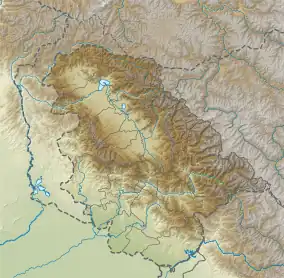 Shown within Jammu and Kashmir  Amarnath Temple (India) | |
| Geographic coordinates | 34.2149°N 75.5008°E |
| Elevation | 3,888 m (12,756 ft) |
| Website | |
| Jksasb.nic.in | |
The Amarnath cave, abode of the Mahamaya Shakti Pitha, is one of the 51 Shakti Pithas, the temples of the Indian subcontinent that commemorate the location of the fallen body parts of the Hindu deity Sati.[4]
Shiva Linga

The Shiva Lingam at the shrine is a Swayambhu lingam. The lingam is a natural stalagmite formation inside a 40 m (130 ft) tall cave at an elevation of 3,888 m (12,756 ft) on the Amarnath Mountain, which has a peak of 5,186 metres (17,014 ft). The stalagmite is formed due to the freezing of water drops that fall from the roof of the cave onto the floor, resulting in an upward growth of an ice formation. Here, the stalagmites considered as the lingam, a physical manifestation of Shiva, form a solid-dome-shape. Two smaller stalagmites are thought to represent Parvati and Ganesha.[5]
According to the ancient Hindu texts of the Mahabharata and Puranas a lingam represents Shiva.[6] The lingam waxes during May to August, as snow melts in the Himalayas above the cave, and water seeps into the rocks of the cave; thereafter, the lingam gradually wanes.[1] Religious beliefs hold that the lingam grows and shrinks with the phases of the moon, reaching its height during the summer festival.[7] Hindus believe this is the place where Shiva explained the secret of life and eternity to his divine consort, Parvati.[8][9]
Lidder Valley, where the cave is located, has a number of glaciers.[10] In 2009, glaciologist M. N. Koul, the former head of the geography department at the University of Jammu, has said that while more scientific studies are needed, contributors to change in lingam size could include changes in the water's pathways to the lingum.[10] The cave is made of limestone and gypsum.[11] Heat generated by tourists affects the size of the stalagmite.[11] Outside temperate changes also affect their size.[12][13] To minimize artificially induced temperature changes, helicopter trips and helipad sites are regulated.[10] There has been talk of artificially extending the life of the stalagmites, this has met with objections.[10][11]
History
Ancient history
The book Rajatarangini (Book VII v. 183) refers to Krishaanth or Amarnath. It is believed that in the 11th century CE, Queen Suryamati gifted trishulas, banalingas and other sacred emblems to this temple.[14] Rajavalipataka, begun by Prajna Bhatta, contains detailed references to the pilgrimage to Amarnath Cave Temple. In addition, there are further references to this pilgrimage in many other ancient texts.
Medieval history
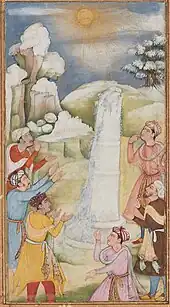
The cave and the Shivling finds mention in Abu'l Fazl's 16th century work Ain-i-Akbari. According to him, the site attracted many pilgrims. He describes the waxing and waning of the lingam according to the seasons and the moon.[15] François Bernier, a French physician, accompanied Emperor Aurangzeb during his visit to Kashmir in 1663. In his book Travels in Mughal Empire, he provides an account of the places he visited, noting that he was "pursuing journey to a grotto full of wonderful congelations, two days journey from Sangsafed" when he "received intelligence that my Nawab felt very impatient and uneasy on account of my long absence." The "grotto" referenced in this passage is the Amarnath cave — as the editor of the second edition of the English translation of the book, Vincent A. Smith, makes clear in his introduction. He writes: "The grotto full of wonderful congelations is the Amarnath cave, where blocks of ice, stalagmites formed by dripping water from the roof are worshipped by many Hindus who resort here as images of Shiva...."[16]
Modern history

In 1895, pilgrims would first travel to Kheer Bhawani for a brief stop.[17] Sustained by free rations from the state, the pilgrims would then travel to Srinagar.[17] From Srinagar, in batches, the pilgrims would then head up Lidder Valley, stopping at locations for holy dips.[17] At Mach Bawan, local Hindus would join them. Maliks of Batok were responsible for the route during these years.[17] Sister Nivedita, in Notes of Some Wanderings with the Swami Vivekananda, writes of Swami Vivekananda's visit to the cave in 1898.[18]
2016: Kashmir unrest
The Amarnath pilgrimage was suspended in July 2016 due to the Kashmir unrest.[19] Some Sufis and Shias later demanded resumption of the Yatra. Kalbe Jawad, a Shia cleric and general secretary of Majlis-e-Ulama-e-Hind and Sufi cleric Hasnain Baqai expressed concern that the tradition had been suspended because of upheaval in Kashmir.[20]
2019: Threat of terrorist attack
The pilgrimage was suspended in August 2019 after the state government stated there was a threat of terrorist attacks. Similarly, the pilgrimage to Machail Mata was suspended as well.[21] However, it was also speculated that the Yatra suspension might have been linked to the revocation of the special status of Jammu and Kashmir.[22][23][24][25]
2020 and 2021: COVID-19 pandemic
The annual pilgrimage was cancelled in the year 2020 and 2021 due to COVID-19 pandemic.[26] On 22 April 2020, the Shri Amarnath Ji Shrine Board announced the suspension of the Yatra because of the COVID-19 pandemic in India. Later however it withdrew the press circular and announced cancellation of the suspension.[27] Lieutenant Governor G. C. Murmu said that a final decision would depend on future developments related to the pandemic.[28] In light of the pandemic, the union territory government on 4 July announced that only 500 people would be permitted road travel to the shrine and everyone entering Jammu and Kashmir would be tested for COVID-19, and quarantined until their reports came back negative.[29] The pilgrimage was later cancelled on 21 July due to the pandemic, with cases of coronavirus in the union territory increasing greatly since 1 July.[30] Facilities for viewing the prayer ceremony online were made available.[31]
The shrine board on 27 March 2022 decided to resume the pilgrimage after a gap of two years, starting from 30 June and lasting for 43 days, while following protocols to prevent the spread of COVID.[32]
2022: temporary suspension due to flash flood
On 8 July 2022, at least 16 people were killed, over 40 missing,[33] and dozens were injured while around 15000 pilgrims were stranded near the Amarnath Holy cave due to a flash flood triggered by a cloudburst near the Lidder Valley en route to the venerated cave.[34] The Amarnath Yatra was halted due to the flash flood on 8 July for 3 days.[35]
Legends
| Part of a series on |
| Shaivism |
|---|
 |
|
|
According to legend, Sage Bhrigu was the first to discovered Amarnath. A long time ago, it is believed that the Valley of Kashmir was underwater, and Sage Kashyapa drained it through a series of rivers and rivulets. As a result, when the waters drained, Bhrigu was the first to have darshan of Shiva at Amarnath. Thereafter, when people heard of the lingam, it became an abode of Shiva for all believers and the site of an annual pilgrimage, traditionally performed by lakhs of people in July and August during the Hindu holy month of Savan.[36]
It is believed that Shiva left Nandi, the bull, at Pahalgam (Bail Gaon). At Chandanwari, he released the Moon from his hair (Jata). On the banks of Lake Sheshnag, he released his snake. At Mahagunas Parvat (Mahaganesh Mountain), he left his son Ganesha. At Panjtarni, Shiva left behind the five elements – Earth, Water, Air, Fire and Sky. As a symbol of sacrificing the earthly world, Shiva performed the Tandava Dance. Then, finally, Shiva entered the Amarnath Cave along with Parvati and both of them manifested into a lingam made of ice. Shiva became the lingam of ice and Parvati became the yoni of rock.[37]
Yatra (pilgrimage) details and routes

Pilgrimage opening timeframe: July–August during ice lingam formation
Pilgrims visit the holy site during the 45-day season around the festival of Shravani Mela in July–August, coinciding with the Hindu holy month of Shraavana.[38] The Amarnath Yatra pilgrimage occurs when the iced stalagmite Shiva lingam reaches the apex of its waxing phase through the summer months.[39] The period of July–August is a popular time for the pilgrimage.[40][41][42] The beginning of the annual pilgrimage is marked by pratham pujan (transl. first prayer).[43][44]
The time frame, during which the pilgrimage remains open, depends on the formation of iced lingam. For example, in 1995 the pilgrimage remained open for 20 days. From 2004 to 2009, it remained open for 60 days. During the following years, it remained open for between 40 and 60 days.[45] In 2019, the Yatra remained open for 46 days from 1 July to 15 August.[46]
State quotas and mandatory pilgrim pre-registration & e-tracking
Pilgrims have to pre-register months in advance and are allotted quotas according to state. States comprising a majority of the allotment include Uttar Pradesh, Punjab, Gujarat, Maharashtra and West Bengal.[47] To ensure the health and safety of the pilgrims, such as during the disaster or medical emergency etc., each pilgrim and vehicle is given a unique wearable traceable identification tag which are scanned at the several designated places along the pilgrim route.[48] Since 2019, pilgrims are given identification cards for the duration of the pilgrimage which are scanned at several locations for tracing the pilgrims.[48] Similarly, the vehicles are also tracked via the tags, so that the entire pilgrimage can be traced.[48][49] the registration fee in 2022, on the "first come, first serve basis", was INR150 per pilgrim.
Transport and roads
Nearest airport is Srinagar International Airport. Nearest railway stations are on the Jammu-Baramulla line - Srinagar railway station for the north pilgrim route through Baltal and Anantnag railway station for the south route via Pahalgam-Chandanwari. The State Road Transport Corporation and private transport operators provide the regular services from Jammu to Pahalgam and Baltal. Also privately hired taxis are available from Jammu, Anantnag, Pahalgam, Srinagar, etc.
On the south route via Pahalgam-Chandanwari, the helicopter services from Chandanwari base camp to Panjtarni (6 km from the cave) are also available from various private operators.[50]
Chandanwari-Sangam Highway as part of NH501, including 11 km long Khanabal-Baltal Tunnel (Sheshnag Tunnel) under the Mahaganus Top (Ganesh Top), is the 22 km long greenfield section of the national highway on the South Route which will connect the South and North yatra routes via the highway tunnel. In January 2023, MoRTH's NHIDCL invited RFP submissions by vendors by 20 Feb 2023 for preparation of DPR (detailed project report) which will take 10 months to prepare, subsequently after 2 months long pre-construction preparation the construction will take 5 years, with the target completion date of 31 March 2029 (total 6 years).[51]
Two main routes
Devotees travel on two main routes which are partially motorable and partially foot-track near to the holy cave: the shorter but steeper 13 km northern route from Baltal Basecamp, and the longer but easier and busier 43 km Pahalgam-Chandanwari basecamp route.[50]
South route – 43 km: Pahalgam-Chandanwari route
It begins with a 43 kilometres (27 mi) mountainous trek from the Nunwan and Chandanwari basecamp at Pahalgam and reaches the cave-shrine after night halts at Sheshnag Lake and Panchtarni camps.[52] The journey from Pahalgam takes about five days.[50] It runs from Pahalgam (on Jammu-Srinagar NH) to Chandanwari Basecamp (9,500 ft) – 16 km, Pissu Top – 3 km, Zoji Bal-Naga Koti-Sheshnag (11,730 ft) – 9 km, Waribal-Mahaguns Yop (Ganesh Top, 14,500 ft) – 4.6 km, Pabibal-Panchtarni (22,729 ft)-Sangam (T-section for North route via Baltal) – 6 km, Amarnath cave – 3 km. The whole foot track route takes three to five days one way.
The route is motorable up to Chandanwari, which will become motorable up to Sangam after construction of NH501 Chandanwari-Baltal Highway which includes Khanabal-Baltal Tunnel (Sheshnag Tunnel) under the Mahaganus Top (Ganesh Top), see "Transport" section above.[51] Once completed, all the route will become motorable except the last 3 km from Sangam to Amarnath cave.
North route – 13 km: Baltal route
It runs from Baltal basecamp to Domail – 2 km, Barari – 5 km, Sangam (T-section for South route via Pahalgam-Chandanwari) – 4 km, Amarnath cave - 3 km. This track is motorable till Baltal and Baltal-Amarnath foot track takes one to two days return trip. Once the NH501 from Pahalgam-Chandanwari to Baltal is completed, including Sheshnag-Sangam tunnel under the Mahaguns Top (Ganesh Top), this route will become motorable except the last 3 km from Sangam to Amarnath cave. This shorter route is just about 14 km long, but has a very steep gradient and is quite difficult to climb. The route is along the Amarnath valley and all along the route one can see the Amaravati river (a tributary of Chenab) which originates from the Amarnath Glacier.
Ancient route: Awantipur-Pissu Top-Sheshnag-Panchtarni
Bhrigu's Amarnath Mahatmya identifies a number of location on the pilgrimage on the way to the Amarnath cave: Shurahyar, Shivpora, Pandrethan, Pampore, Javati, Awantipur, Barsu, Jaubror, Belihar, Wagahama, Chakreshwar (Tsakdar), Hari Chandar, Sthalwat (Thajwor), Suryai Gohwat (Sriguphvara), Lambodari, Sirham, Bodrus, Bala Khelyan, Ganish, Mammaleshwar, Bhrigupati Kshetra, Nila Ganga, Pissu Hill (Pissu Top), Sheshnag, Wavjan, Panchtarni, Amravati.[53] On the return journey Mamleshwar and Naudal are crossed.[54] Following the construction of drivable road, alignment of this pilgrimage route has presently changed at some places (which has now become "South route" - see above).[54]
Organisation and facilities
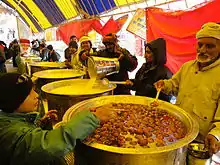
Officially, the Yatra is organised by the government in collaboration with the Shree Amarnath Shrine Board (SASB). Various agencies provide necessary facilities all along the route during the Yatra period, which includes provision of ponies, supply of power, telecommunication facilities, firewood and setting up of fair price shops.[50]
En route to the cave, various non-governmental organisations have set up food supply and resting tents called pandals which are available for free to the pilgrims. Near the shrine, hundreds of tents which are erected by locals can be hired for a night's stay.[50]
Srinagar Pilgrimage Centre, with capacity to host 3000 yatris, facilitates pilgrims' stay who are travelling for the holy pilgrimage. The state government began its construction in May 2022.[38]
Security of pilgrims
Every year, thousands of central armed forces and state police personnel are deployed to provide security to pilgrims from potential terror threats. The forces position at various halts and also on the perimeter of the shrine.[55] These include CRPF, BSF, ITBP, NDRF/SDRF and state police and traffic police.[56]
Economic impact of yatra
The yatra is a way of earning revenue for the state government by imposing tax on pilgrims.[57][58] Local Muslim Bakarwal-Gujjars also make a living by offering services to the Hindu pilgrims. This source of income has been threatened by the Kashmiri militant groups who have harassed and attacked the yatra numerous times.[20][59][60][61][62][63]
Annual number of pilgrims
The number of annual pilgrims having generally rising consistently from between 12,000[64][65]-20,000[66]-30,000 in 1989,[67] to over 400,000 in 2007,[65][68] 634,000 in 2011,[69] 622,000 in 2012,[70] 350,000 in 2013,[70] 285,006 in 2018.[71]
| Year | Pilgrims | Days | Ref | Year | Pilgrims | Days | Ref | Year | Pilgrims | Days | Ref |
|---|---|---|---|---|---|---|---|---|---|---|---|
| 2021 | — | [72] | 2009 | 381,000 | 60 | [70] | 1997 | 79,035 | [73] | ||
| 2020 | — | [74] | 2008 | 533,000 | 60 | [70] | 1996 | ||||
| 2019 | 342,883 | 45 | [75][76] | 2007 | 2.14/2.96 lakh | 60 | [77][70] | 1995 | 70,000 | 20 | [78] |
| 2018 | 285,006 | [71][79] | 2006 | 2.65/3.47 lakh | 60 | [77][80] | 1994 | ||||
| 2017 | 260,003 | [79] | 2005 | 388,000 | 60 | [80] | 1993 | 75,000* | [81] | ||
| 2016 | 220,490 | [79] | 2004 | 400,000 | 60 | [80] | 1992 | 50,000* | [81][82] | ||
| 2015 | 352,771 | 60 | [79] | 2003 | 153,314 | 30 | [73] | 1991 | 30,000* | [81] | |
| 2014 | 372,000 | [83] | 2002 | 110,793 | 30 | [73] | 1990 | 4,000* | [81] | ||
| 2013 | 353,000 | 55 | [70] | 2001 | 119,037 | [73] | 1989 | 12,000-40,000* | [65][68] | ||
| 2012 | 622,000 | [70] | 2000 | 173,334 | 30 | [73] | Source: Duration[45] | ||||
| 2011 | 634,000 | [70] | 1999 | 114,366 | 40 | [73] | |||||
| 2010 | 455,000 | [70] | 1998 | 149,920 | [73] | ||||||
Incidents
Deaths due to health, accidents and disasters
Sir Walter Roper Lawrence in The Valley of Kashmir (1895) writes that the difficulty of the pilgrimage route affected the weak and sick, with many also falling victim to cholera.[84] In 1928, over 500 pilgrims and mules died on the way to the cave.[85] In 1969 a cloudburst resulted in the death of 40 pilgrims.[85] The 1996 Amarnath Yatra tragedy involved the death of 243 pilgrims due to exhaustion and exposure.[86][64] In July 2012, 12 pilgrims were killed in a road accident. The pilgrims were part of a team who had set up a community kitchen at the pilgrimage.[87] Three people were killed and more injured due to a cloudburst at Baltal in 2015.[88] Of the 622,000 yatra pilgrims in 2012, 130 died during the yatra. The major cause was attributed to people who were not physically fit for the arduous climb, high elevations, and adverse weather undertaking the yatra. Some also died in road accidents before reaching the base camp from where the yatra starts. Of the 130 deaths, 88 were due to purported health reasons and 42 in road accidents.[89] On 16 July 2017, 18 pilgrims died and many were seriously injured after a JKSRTC bus, which was plying from Jammu city to Pahalgam as part of an Amarnath Yatra convoy, fell into a 150-ft deep gorge near Nachlana area of Jammu's Ramban district around 1:45 pm. 16 pilgrims had died on the spot, while two succumbed later to their injuries.[90] This accident happened less than a week after a deadly terrorist attack on a bus carrying Amarnath Yatra pilgrims from Gujarat.
On 8 July 2022, at around 5:30 pm, flash floods due to a localised cloudburst near the holy cave shrine washed away scores of pilgrims. According to reports, at least fifteen pilgrims died in the incident. Jammu and Kashmir lieutenant-governor Manoj Sinha announced compensation of Rs 5 lakh each to the families of the 15 pilgrims who died in the flash floods.[91][92]
Threats, attacks, and massacres
The first threat targeted against Amarnath pilgrims was in 1993; that year Pakistan-based Harkat-ul-Ansar had announced a ban due to demolition of Babri Masjid in the previous year.[93] The pilgrimage however was mostly peaceful.[93] The Harkat-ul-Mujahideen group imposed what it called a "ban" on the yatra in 1994, 1995 and 1998 while threatening the pilgrims with "serious consequences"; however the pilgrimage did continue.[94][95]
2000 pilgrimage massacre
On 2 August 2000, militants attacked the Nunwan base camp in Pahalgam. Thirty-two people, including 21 unarmed Hindu pilgrims, seven unarmed Muslim civilians and three security force officers, in a two hour long indiscriminate shoot, were killed.[60][96] Among the dead were mostly pilgrims and porters and horsemen who were ferrying pilgrims.[97][98] This attack was part of the larger 1–2 August 2000 Kashmir massacre in five separate coordinated terrorist attacks that killed between 89 (official count) and 105 people (as reported by PTI), and injured at least 62 more.[60][97] Then Indian Prime Minister Atal Bihari Vajpayee blamed Lashkar-e-Taiba for the killings.[99]
2001 massacre
On 20 July 2001, a terrorist threw a grenade on a pilgrim night camp at Sheshnag near the Amarnath shrine and at least 13 persons, including three women, were killed in two explosions and firing by militants; two were security officials and three were Muslim civilians.[62][59] 15 other were also injured in the attack.[100]
Controversies
2008 land transfer controversy
On 26 May 2008, the Government of India and the state government of Jammu and Kashmir reached an agreement to transfer 100 acres (0.40 km2) of forest land to the Shri Amarnathji Shrine Board (SASB)[102] to set up temporary shelters and facilities for Hindu pilgrims. Kashmiri separatists opposed the move citing reasons that it would jeopardise Article 370 that gives separate identity to the people of Jammu and Kashmir and prevents any Indian citizen settling in Kashmir. People in Kashmir staged widespread protests against this decision by the government of India.[103] Due to the protests, the J&K State government relented and reversed the decision to transfer land. As a result, Hindus in the Jammu region launched counter-agitations against this roll back.[104][105]
Environmental impact
Environmentalists have expressed concern that the number of people participating in the Amarnath Yatra is having a negative impact on the area's ecology and some have expressed support for government regulated limits on the number of pilgrims permitted to make the trek.[106] However no studies have been made nor has an environmental impact assessment done. To date, the Government of India restricts travellers only on the basis on logistics, time window for the yatra and weather.
Amarnath Cave Temple Yatra tax controversy
The Government of Jammu and Kashmir had in 2010 issued a notification under the State Motor Vehicle Taxation Act 1957, under which vehicles going to Amarnath Yatra will have to pay a tax of ₹ 2,000 for seven days and ₹ 2,000 per day after that. Similar provisions were made for pilgrims going to Sri Mata Vaishno Devi under which they need to pay ₹ 2000 for a period of three days. India's largest political party the Bharatiya Janata Party expressed its ire over imposition of entry fee and accused the then UPA led central government to direct the Jammu and Kashmir dispensation to desist from making attempts to "discriminate" between followers of various religions. The BJP criticised the decision as "reminiscent of Jizya imposed during [the] Mughal period on Hindus". In response to the question in Lok Sabha (Lower house of the Indian Parliament) then Minister of State for Finance, S. S. Palanimanickam clarified that tax is levied on all India Tourist Vehicles entering the state and it was therefore not correct to say that the Government of Jammu & Kashmir was levying any additional tax on vehicles going to Amarnath and Vaishno Devi. He also said that Taxation of Motor vehicles falls under the purview of State Governments as per the seventh schedule of the Constitution of India and Central Government cannot direct the State Government to change the tax rate on vehicles.[107][58]
Popular culture
Santoor artist Rahul Sharma named a track after Amarnath Cave temple as "Shiva Linga: The Amarnath Cave".[108]
Gallery
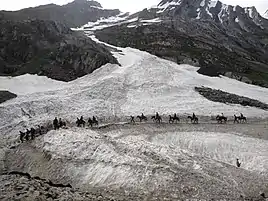 Pilgrims riding ponies on the way to the Amarnath Cave Temple
Pilgrims riding ponies on the way to the Amarnath Cave Temple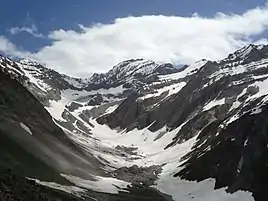 On the way to the Amarnath Cave Temple
On the way to the Amarnath Cave Temple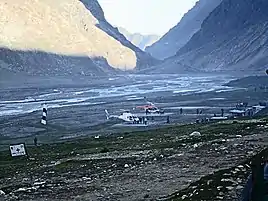 Helicopter service up to panjtarni en route to the Amarnath Cave Temple
Helicopter service up to panjtarni en route to the Amarnath Cave Temple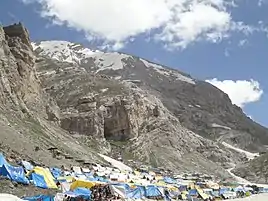 Tents are available to hire for a small fee near the base of the imposing Amarnath Cave as visible in the background.
Tents are available to hire for a small fee near the base of the imposing Amarnath Cave as visible in the background.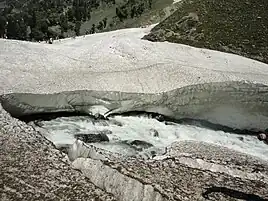 Glacier over Lidder River in Chandanwari on the way to the Amarnath Cave Temple
Glacier over Lidder River in Chandanwari on the way to the Amarnath Cave Temple
See also
- Kanwar Yatra, another popular Hindu pilgrimage
- List of caves in India
- List of rock-cut temples in India
References
- "Amarnathji Yatra - a journey into faith". Official Web Site of Jammu and Kashmir Tourism. Archived from the original on 16 June 2006. Retrieved 15 June 2006.
- "New shrine on Amarnath route". The Hindu. Chennai, India. PTI. 30 May 2005. Archived from the original on 18 June 2007. Retrieved 15 November 2006.
- "The pilgrimage to Amarnath". BBC News. 6 August 2002. Archived from the original on 6 January 2012. Retrieved 5 May 2012.
- Shankar, Ravi (26 September 2021). "Motherlodes of Power: The story of India's 'Shakti Peethas'". The New Indian Express. Archived from the original on 26 September 2021. Retrieved 28 December 2021.
- MurukutlaParvezImrozSeshadri 2017, p. 9.
- "lingam". Encyclopædia Britannica. 2010. Archived from the original on 4 May 2015. Retrieved 3 February 2017.
- Ortner, Jon, "On the road again" Archived 17 October 2006 at the Wayback Machine. PDN Gallery.
- Shantha N. Nair, "The Holy Himalayas", pp.84.
- "Amarnath Cave - The legend". Bhole Bhandari Charitable Trust. Archived from the original on 1 February 2007. Retrieved 19 November 2006.
- Santoshi, Neeraj (4 June 2009). "Helicopter sorties changed to prevent melting of Amarnath ice lingam". The Indian Express. Archived from the original on 28 December 2021. Retrieved 28 December 2021.
- Chandrasekharam, D. (2007). "Geo-mythology of India". In Piccardi, Luigi; Masse, W. Bruce (eds.). Myth and Geology. Geological Society of London. p. 32. ISBN 978-1-86239-216-8.
- "Amarnath Lingam melts away". Hindustan Times. PTI. 1 July 2007. Archived from the original on 8 August 2020. Retrieved 28 December 2021.
- Wani, Ashraf (15 July 2016). "Amarnath's Shivlinga melts in just 13 days this year". India Today. Archived from the original on 28 December 2021. Retrieved 28 December 2021.
- "Amarnath Yatra: In Search of Salvation". Shriamarnathyatra.net. Archived from the original on 17 June 2013. Retrieved 15 April 2013.
- Natif, Mika, "Mughal men admiring the miraculous ice lingam at Amarnath", Aga Khan Museum
- Mohini Qasba Raina (2013). Kashur The Kashmiri Speaking People. Partridge Publishing Singapore. p. 327. ISBN 978-1-4828-9945-0. Archived from the original on 21 December 2019. Retrieved 13 December 2018.
- Lawrence 1895, p. 298-299.
- Sister Nivedita, Notes of Some Wanderings with the Swami Vivekananda (1913), p. 148-150.
- Tabassum, Huma, ed. (8 July 2017). "Amarnath Yatra Suspended from Jammu Due to Kashmir Situation". News18. PTI. Archived from the original on 8 October 2017. Retrieved 8 October 2017.
- "Muslim group asks for reviving Amarnath Yatra". The Times of India. 17 July 2016. Archived from the original on 11 December 2018. Retrieved 27 December 2021.
- "Don't Panic, Jammu & Kashmir Governor Tells Political Parties as Tourists and Pilgrims Leave Valley". News18. 3 August 2019.
- Das, Shaswati; Bhaskar, Utpal (7 August 2019). "The events that led to Jammu and Kashmir losing its special status". Livemint. Archived from the original on 7 August 2019. Retrieved 9 May 2020.
- Singh, Sumit Kumar (3 August 2019). "Amarnath yatris, tourists told to move out of J&K immediately". Daily News and Analysis (DNA). Archived from the original on 1 November 2019. Retrieved 9 May 2020.
- "Ex-CMS Mehbooba Mufti and Omar Abdullah Detained, Shifted to Guest House from House Arrest". News18. 6 August 2019. Archived from the original on 28 November 2019. Retrieved 9 May 2020.
- IANS (6 August 2019). "Kashmiris completely cut off as Modi govt revoked Article 370, declares Jammu and Kashmir Union Territory". National Herald. Retrieved 27 December 2021.
- "After a gap of two years, Amarnath Yatra sets to begin tomorrow". Retrieved 29 June 2022.
- "Coronavirus outbreak: Uncertainty over Amarnath yatra as SASB release announcing decision to cancel pilgrimage withdrawn". Deccan Herald. PTI. 22 April 2020. Archived from the original on 27 April 2020. Retrieved 9 May 2020.
- "Decision on Amarnath Yatra after review of Covid-19 situation: J&K LG Murmu". Business Standard India. 26 April 2020. Archived from the original on 7 May 2020. Retrieved 9 May 2020.
- Wani, Ashraf (5 July 2020). "Amarnath Yatra 2020: J&K administration allows 500 pilgrims per day". India Today. Retrieved 11 July 2020.
- "Amarnath Yatra cancelled due to spike in coronavirus infections". Hindustan Times. 21 July 2020. Retrieved 22 July 2020.
- "Amarnath Yatra 2021: Pilgrimage cancelled but devotees can watch live aarti online, check details". The Financial Express. 28 June 2021. Archived from the original on 28 June 2021. Retrieved 27 December 2021.
- "Amarnath Yatra set to resume from 30 June; to last 43 days. Details here". Mint. 27 March 2022. Retrieved 5 April 2022.
- Rashid, Hakeem Irfan. "Amarnath flash floods: 16 dead, 40 missing in ; yatra on hold". The Economic Times. Retrieved 17 July 2022.
- "Backstory: Why Was the Media So Eager to Put the Amarnath Yatra Tragedy Behind Them?". The Wire. Retrieved 17 July 2022.
- "Amarnath Yatra resumes 3 days after cloud burst; Administration rejects charge of ignoring flood risk". Financialexpress. Retrieved 17 July 2022.
- Gray, Martin. "Amarnath Cave, Kashmir". World Pilgrimage Guide. Retrieved 20 January 2020.
- Saraswat, Lalit (11 March 2012). "Shiv Shankar's secret of immortality and the Amarnath Cave". ShivShankar.in. Archived from the original on 24 August 2012. Retrieved 6 June 2012.
- "J&K LG takes part in 'Bhoomi Pujan' of Amarnath Yatri Niwas in Srinagar". daijiworld.com. Retrieved 5 May 2022.
- Reader 2013, p. 83-84.
- "Amarnath Yatra explained" Archived 6 July 2017 at the Wayback Machine, Amarnath Yatra organisation .
- "Amarnath: Journey to the shrine of a Hindu god" Archived 8 July 2017 at the Wayback Machine, Boston.Com Archived 29 March 2016 at the Wayback Machine, 13 July 20112.
- "Hiking through the mountains of Kashmir". The Economist. 27 September 2012. Archived from the original on 8 October 2017. Retrieved 8 October 2017.
- Ahmad, Mukhtar (15 June 2011). "Amarnath yatra's pratham pujan held near Pahalgam". Rediff. Archived from the original on 23 June 2011. Retrieved 27 December 2021.
- Ahmad, Mukhtar (19 June 2011). "Amarnath yatra likely to start from June 29". Rediff.com. Archived from the original on 22 June 2011.
- MurukutlaParvezImrozSeshadri 2017, p. 28.
- "Amarnath Yatra 2015 to commence on July 2 and finish on August 29". Bihar Prabha News. 14 April 2015. Archived from the original on 17 April 2015. Retrieved 14 April 2015.
- MurukutlaParvezImrozSeshadri 2017, p. 36-37.
- Sen, Sudhi Ranjan (15 June 2019). "In a first, Amarnath pilgrims to be tagged for a safe trek". Hindustan Times. Archived from the original on 15 June 2019. Retrieved 27 December 2021.
- Reader 2013, p. 84.
- Handoo, Ashok (7 June 2011). "Amarnath Yatra 2011- The Countdown Begins". Northern Voices Online. Archived from the original on 12 May 2013. Retrieved 15 April 2013.
- Amarnath Road Project: हर मौसम में अमरनाथ पहुंचना होगा आसान, सुरंग के साथ 22Km लंबा रोड बनाने की योजना., News18, 18 Jan 2023.
- "Amarnath yatra ends, least number of pilgrims in decade". The Hindu. PTI. 18 August 2016. ISSN 0971-751X. Archived from the original on 9 January 2020. Retrieved 27 December 2021.
- Warikoo 2009, p. 132-134.
- Warikoo 2009, p. 134.
- "High security on Amarnath Yatra routes". Ibnlive.in.com. 29 June 2011. Archived from the original on 3 July 2011. Retrieved 15 April 2013.
- MurukutlaParvezImrozSeshadri 2017, pp. 45–46.
- "Remove entry fee on buses to Vaishno Devi, Amarnath: BJP". The Times of India. 18 June 2020. Archived from the original on 16 February 2019. Retrieved 27 December 2021.
- "No Additional Tax Levied on Vehicles Going to Amarnath and Vaishno Devi". Press Information Bureau, Ministry of Finance, Government of India. 27 August 2010. Archived from the original on 16 February 2019. Retrieved 27 December 2021.
- Fazili, Ehsan (21 July 2001). "6 pilgrims among 13 killed in 2 blasts. Amarnath Yatra suspended; Shabir blames Hindu extremists". The Tribune India. Archived from the original on 12 July 2012. Retrieved 27 December 2021.
- Vicky Nanjappa (11 July 2017). "Amarnath yatra has been attacked thrice in the past" Archived 11 July 2017 at the Wayback Machine, One India News Archived 12 July 2017 at the Wayback Machine.
- "Amarnath yatra: Terrorists were directed to eliminate 100 to 150 pilgrims, says intelligence report". The Hindu. 11 July 2017. ISSN 0971-751X. Retrieved 27 December 2021.
- "Amarnath terror attack survivor narrates tale of punctured bus tyre and terror strike". India Today. 10 July 2017. Archived from the original on 12 July 2017. Retrieved 12 July 2017.
- "Chronology of Major Killings in Jammu and Kashmir". Kashmir Herald. Vol. 2, no. 11. April 2003. Archived from the original on 6 August 2017.
- Navlakha, Gautam (2006). "Pilgrim's Progress Causes Regression". Economic and Political Weekly. 41 (27/28): 2975–2977. ISSN 0012-9976. JSTOR 4418427.
- Reader 2013, p. 42.
- Roy, Arundhati (1 September 2008). "Azadi". Outlook Magazine. p. 15.
- Mehta, Deepak; Roy, Rahul (1 January 2018). Violence and the Quest for Justice in South Asia. SAGE Publishing India. ISBN 978-93-5280-654-6.
- Rohde, David (5 August 2002). "Braving Nature and Militants, Hindus Trek for a Peek at a God's Icy Symbol". The New York Times. ISSN 0362-4331. Retrieved 28 December 2021.
- "Amarnath yatra: Record 6.34 lakh visit shrine". Zee News. 12 August 2011. Archived from the original on 9 March 2012. Retrieved 15 April 2013.
- "Amarnath yatra ends today, least number of pilgrims in decade". The Economic Times. PTI. 18 August 2016. Retrieved 28 December 2021.
- Hussain, Ashiq (26 August 2018). "Amarnath Yatra ends with a three-year high of 2.85 lakh pilgrims". Hindustan Times. Archived from the original on 26 August 2018. Retrieved 28 December 2021.
- "Amarnath Yatra cancelled for second year in a row due to Covid-19". The Times of India. 21 June 2021. Archived from the original on 21 June 2021. Retrieved 28 December 2021.
- Annual Report 2003-04 (PDF). Ministry of Home Affairs, Government of India (Report). p. 32. Archived (PDF) from the original on 29 July 2021.
- "Amarnath Yatra cancelled in light of COVID-19 pandemic". Times of India Travel. 22 July 2020. Archived from the original on 22 July 2020. Retrieved 28 December 2021.
- "Annual Report 2019-20" (PDF). Ministry of Home Affairs, Government of India. p. 280. Archived (PDF) from the original on 20 April 2021.
- "Over 1 lakh pilgrims perform Amarnath Yatra in 8 days". India Today. Press Trust of India. 9 July 2019. Archived from the original on 9 July 2019. Retrieved 28 December 2021.
- Warikoo 2009, p. 137.
- "Annual Report 1995-96" (PDF). Ministry of Home Affairs, Government of India. p. 99. Archived (PDF) from the original on 28 December 2021.
- "Amarnath yatra crosses last year's figure of 2.85 lakh pilgrims". India Today. Press Trust of India. 23 July 2019. Archived from the original on 8 November 2020. Retrieved 28 December 2021.
- Majid, Zulfikar (27 July 2019). "In 26 days, 3.15 lakh pilgrims perform Amarnath yatra". Deccan Herald. Archived from the original on 29 November 2020. Retrieved 28 December 2021.
- Baweja, Harinder (31 August 1994). "Further setbacks in Kashmir as militants ban Amarnath yatra, removal of bunkers in Hazratbal". India Today. Archived from the original on 3 August 2019. Retrieved 28 December 2021.
- Baweja, Harinder (31 August 1994). "Further setbacks in Kashmir as militants ban Amarnath yatra, removal of bunkers in Hazratbal". India Today. Archived from the original on 3 August 2019. Retrieved 4 August 2018.
- Rashid, Hakeem Irfan (26 January 2021). "J&K planning for arrival of six lakh Amarnath pilgrims, highest in last eight years". The Economic Times. Retrieved 28 December 2021.
- Lawrence 1895, pp. 298–299.
- Warikoo 2009, p. 136.
- Chakravarty, Sayantan; Baweja, Harinder (15 September 1996). "Freak weather conditions during Amarnath yatra claim 200 lives". India Today. Archived from the original on 9 September 2020. Retrieved 27 December 2021.
- "16 Amarnath Yatra pilgrims killed in road accident". NDTV. PTI. 27 July 2012. Archived from the original on 21 July 2017. Retrieved 27 December 2021.
- Akhzer, Adil (26 July 2015). "Amarnath: 3 killed, 11 injured as cloudburst hits yatra base camp in Baltal". The Indian Express. Archived from the original on 26 July 2015. Retrieved 27 December 2021.
- "Amarnath yatra ends, Charri Mubarak reaches shrine". The Economic Times. PTI. 2 August 2012. Retrieved 27 December 2021.
- "16 Amarnath yatris killed as bus falls into 150-foot gorge". The New Indian Express. Retrieved 10 July 2022.
- Masoodi, Nazir; Chhabra, Aarish (14 July 2022). ""No One Missing": 6 Days After Amarnath Flash Floods, Jammu And Kashmir Lt Governor Clarifies". NDTV. Archived from the original on 14 July 2022. Retrieved 6 September 2023.
- Pandit, M. Saleem (15 July 2022). "Rs 5 lakh for Amarnath cloudburst victims' kin". The Times of India. Archived from the original on 14 July 2022. Retrieved 6 September 2023.
- Jaleel, Muzamil (9 July 1998). "Why Amarnath Yatra terror attack signals crossing of a red line in Kashmir". The Indian Express. Archived from the original on 3 August 2019. Retrieved 15 April 2013.
- Ahmad, Mukhtar (9 July 1998). "Harkatul Mujaheedin 'bans' Amarnath Yatra". Rediff.com. Archived from the original on 30 September 2018. Retrieved 15 April 2013.
- Reference to the Death of Pilgrims of Amarnath Yatra. 26 August 1996. Session Journal. Council of States, Rajya Sabha, Parliament of India. Archived 28 December 2021 at the Wayback Machine
- "Amarnath pilgrimage resumes". BBC News. 4 August 2000. Archived from the original on 24 August 2017. Retrieved 27 December 2021.
- "Night of massacres leaves 105 dead in valley. Army out in Jammu. Central team in Srinagar". The Tribune India. 3 August 2000. Archived from the original on 14 July 2017. Retrieved 27 December 2021.
- MacKinnon, Ian (2 August 2000). "Muslim militants kill 21 Hindu pilgrims in Kashmir". The Independent. Archived from the original on 25 September 2015.
- "Prime Minister Vajpayee's statement in Parliament regarding the recent massacre in Jammu & Kashmir". Indianembassy.org. Archived from the original on 4 August 2007. Retrieved 15 April 2013.
- "Amarnath Yatra devotees have faced repeated terror attacks: Here's the blood-soaked history of pilgrimage". Firstpost. 11 July 2017. Archived from the original on 11 July 2017. Retrieved 27 December 2021.
- "Three arrested for attack on Amarnath yatris: IGP Kashmir Munir Khan". The Times of India. 6 July 2017. Archived from the original on 10 August 2017. Retrieved 19 May 2019.
- "SASB CEO replaced over Amarnath land row". India Today. Indo-Asian News Service. 28 June 2008. Archived from the original on 18 May 2021. Retrieved 27 December 2021.
- Raghavan, B. S. (7 August 2008). "Jammu is not for burning". Rediff.com. Archived from the original on 13 August 2008. Retrieved 15 April 2013.
- "Economic blockade affects life in Kashmir". NDTV. 4 August 2008. Archived from the original on 2 September 2017. Retrieved 15 April 2013.
- Bamzai, Sandeep (6 August 2016). "Kashmir: No algorithm for Azadi". ORF. Archived from the original on 10 August 2016. Retrieved 27 December 2021.
- Byerly, Rebecca (12 March 2012). "Massive Hindu Pilgrimage Melting Sacred Glacier". National Geographic News. Archived from the original on 17 March 2012. Retrieved 15 April 2013.
- "Remove entry fee on buses to Vaishno Devi, Amarnath: BJP". The Times of India. PTI. 18 June 2010. Archived from the original on 16 February 2019. Retrieved 27 December 2021.
- "Shiva Linga – The Amarnath Cave: Rahul Sharma". Amazon.co.uk. Archived from the original on 6 August 2018. Retrieved 15 April 2013.
Bibliography
- Murukutla, Kartik; Parvez, Khurram; Imroz, Parvez; Seshadri, Swathi (March 2017), Amarnath Yatra. A Militarized Pilgrimage, Illustrations by Mir Suhail, Jammu Kashmir Coalition of Civil Society
- Sister Nivedita (1913). Swami Saradananda (ed.). Notes of Some Wanderings with the Swami Vivekananda. Udbodhan, Calcutta.
- Reader, Ian (11 September 2013). Pilgrimage in the Marketplace. Routledge. ISBN 978-1-134-62589-5.
- Warikoo, K. (2009). "9. Amarnath- The Abode of the God of Immortality". In Toshkhani, S. S.; Warikoo, K. (eds.). Cultural Heritage of Kashmiri Pandits. Pentagon Press. ISBN 978-81-8274-398-4.
- Lawrence, Sir Walter Roper (1895). The Valley of Kashmír. H. Frowde.
Further reading
- Shah, A. R. (2013). A Sociology Lens of Pilgrimage Tourism in Kashmir Valley: A Case of Holy Amarnath Pilgrimage. The Tibet Journal, 38(3–4), 57–85.
Pilgrim health
- Koul, Parvaiz A.; Khan, Umar Hafiz; Hussain, Tajamul; Koul, Ajaz Nabi; Malik, Sajjad; Shah, Sanaullah; Bazaz, Sajjad Rajab; Rashid, Wasim; Jan, Rafi Ahmad (2013). "High altitude pulmonary edema among "Amarnath Yatris"". Lung India. 30 (3): 193–198. doi:10.4103/0970-2113.116254. ISSN 0970-2113. PMC 3775198. PMID 24049253.
- Navlakha, Gautam (2006). "Pilgrim's Progress Causes Regression". Economic and Political Weekly. 41 (27/28): 2975–2977. ISSN 0012-9976. JSTOR 4418427.
- Basnyat, Buddha (1 December 2014). "High Altitude Pilgrimage Medicine". High Altitude Medicine & Biology. 15 (4): 434–439. doi:10.1089/ham.2014.1088. ISSN 1527-0297. PMC 5118954. PMID 25330393.
- Salaria, Amit Kumar; Kumar, Vishal; Kumar, Prasoon; Dogra, Ekta (2018). "Epidemiology of Orthopaedic Morbidities in Pilgrims of Shri Amarnath Yatra". Journal of Clinical and Diagnostic Research. doi:10.7860/JCDR/2018/37236.12213.
Environment
- Jameel, Yusuf (22 July 2020). "Amarnath ice lingam melts due to high temperature". Deccan Chronicle. Retrieved 27 December 2021.
- Shah, Umar Manzoor (13 June 2019). "Ecological harm from Hindu glacier pilgrimage". Union of Catholic Asian News. Retrieved 27 December 2021.
- "CRPF to launch 'save environment' campaign during Amarnath Yatra". The Times of India. 19 June 2019. Retrieved 27 December 2021.
- "Environmental issues during Amarnath Yatra to be addressed". The Indian Express. 26 February 2009. Retrieved 27 December 2021.
- "Pilgrims welcome but pollution is a worry". Greater Kashmir. 14 March 2015. Retrieved 27 December 2021.


